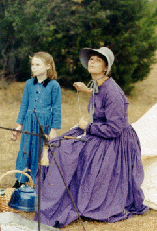Starting Out:
Women's Clothing - 1830s Style
by Sandy Kramer


The easiest way to begin your involvement with pre-1840 historical
reenactment may be to outfit yourself in a suit of period clothes and visit
an encampment for a day. The most sensible and economical way to begin is
with a day dress If your outer wear looks fairly correct, what's underneath
is no one's business but your own!
The first thing I did when I made the decision to sew a period dress
was to look for a pattern. I am no seamstress and needed all the details
down on paper for me. (See the list of resources that follows.) When choosing
a pattern, also bear in mind that any pattern drawn directly from an original
garment was made to fit over a corset and was cut accordingly. Don't let
this discourage you. I've found that by taking the finished gown with you
to any fairly large department store you can find an undergarment that will
not only work, but also be fairly comfortable. I was also pleasantly surprised
at how interested and involved the sales staff can get.
All right, you are on your way to becoming an 1830s Texas woman
searching for a dress pattern. But what exactly are you looking for? Texas
in the 1830s was not the cultural backwater that many people envision it
to have been. In fact, especially in the more settled eastern and coastal
areas, folks were quite fashionable. New Orleans, with its shipping access
to the world was quite near. Women (and men), within their means and abilities,
would dress quite fashionably.
From the late 1820s on, the very high waist of the Regency period
(watch any Jane Austen movie) has been dropping, until by the mid 1830s it
is just a bit above the natural waistline. The high fashion silhouette of
a column has evolved into a silhouette that looks much like two triangles
balanced one on top of the other at their points. The lower triangle is obviously
the full pleated or gathered skirt. The upper triangle, the bodice and sleeves,
is achieved by a dropped shoulder line and full upper sleeves which quite
often fit the arm closely from about the elbow down.
Dresses from this era have surprisingly few fastenings. Either
a front or back closing gown might have a tie at the neckline and waist and
a few hooks or pins in between. I personally feel that although this may
be historically correct, I prefer to remain fully covered while I work around
camp, and opt to sew in considerably more hooks than would have been actually
used!
The fabric for such a dress might have been a lightweight wool,
linen, cotton, or silk. Buy whatever your budget dictates. A cotton print
or solid is perfectly fine, just remember that natural dyes were all that
was available, so colors would have been somewhat subdued. This is not to
say that you can't have a red gown, for example, just don't choose fire engine
red.
Underneath the gown a lady would have worn several petticoats, generally
white hose, and soft flat slippers or a lace-up boot for country wear. A
shawl, cap, and bonnet would complete your outfit. I would also recommend
an apron for camp wear.
With these basic guidelines in mind, come on out and have fun!
Just beware... the quest for information can be addictive and may result
in a closet full of gowns!
Resources and related sites:
BOOKS
- English Women's Clothing in the Nineteenth Century, by C.
Willett Cunnington, 1990
- The Calico Chronicles: Texas Women and Their Fashions, 1830-1910
, by Betty J. Mills, 1985
WEB SITES
- The
Costume Site
- The Regency
Fashion Page
- The
Costume Page
PATTERN SOURCES
- Dixie Gun Works
- Amazon Vinegar and Pickling
Works Drygoods
TLA Homepage
TLA Membership
General Rules and Reg.s
E-mail Information To:
webmaster@texianlegacy.com
|